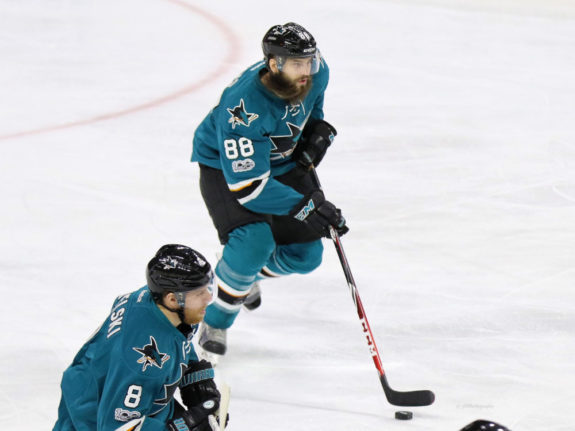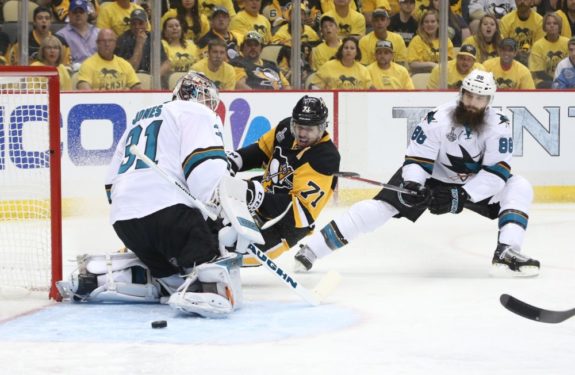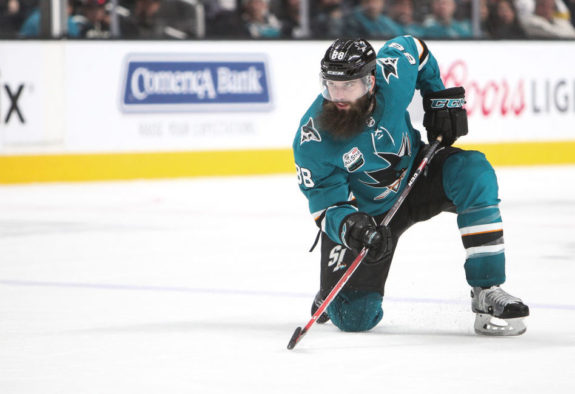Brent Burns added an assist to his point totals Tuesday night in a 5-2 loss to the Edmonton Oilers that concluded the San Jose Sharks’ six-game win streak. He now has 20 points in 22 games this season, representing a 75-point pace. This pace would mark a career year for almost any defender in the league, but for Burns, who has hit the 75-point mark in three of his last four seasons, it’s simply the norm.
Burns’ offensive game is impressive in every aspect. His 669 career points are good for first among all active NHL defensemen. From the start of the 2015-16 season, his 12th season in the league, to the time of writing, Burns is first among defensemen in goals (89), assists (232), and points (320). His .92 points per game played over this time period places him above bonafide forwards including Mark Stone, Anze Kopitar, Phil Kessel, Jamie Benn, and Brayden Point, among others. Additionally, Burns’ 83 points last season was the highest-scoring performance by a defenseman in over two decades – last replicated by Brian Leetch scoring 85 in the 1995-96 season.

Burns has received notable recognition for his production, including winning the Norris Trophy in 2017, being an NHL First All-Star Team selection in 2017 and 2019, and being ranked as the top defenseman in NHL Network’s NHL Top Players ranking for the current season.
Burns’ Journey to Defense
Burns was drafted 20th overall in the 2003 NHL Entry Draft by the Minnesota Wild. Despite being drafted as a right-winger, he was quickly converted to a defenseman by head coach Jacques Lemaire in his debut season. He had moderate success as a defenseman, but his strong rushes, great shot, and other offensive attributes often led the Wild to shift him back up to the right-wing. In 2011, Burns was traded to the Sharks, who were also unsure just how exactly to utilize him, moving him between positions on multiple occasions.

Burns played approximately 90 games for the Sharks on the right-wing, before the club announced prior to the 2014-15 season that he would be back to playing defense. Fans and the media had mixed reviews to this announcement – an article by The Neutral commentated that “Moving Brent Burns back to defense is a mistake”, citing his 68 points in 92 games playing forward to be too instrumental to the Sharks success. As we now know, Burns has actually managed to increase his point totals while playing on the blue line.
However, is Burns essentially still a winger who simply happens to line up on the blue line? While no one can doubt his offensive prowess, many are left wondering if he can really be considered a top defenseman without having much of a defensive game. A notable critic includes Drew Doughty, who made comments against Burns being a potential Norris frontrunner last March.
Since this point, the narrative of Burns being a great defenseman changed for many casual fans. After all, who is more qualified to speak about a defenseman’s ability than two-time Stanley Cup champion, two-time Olympic Gold Medalist, Norris winning, future Hall of Famer Doughty?
Burns’ Defensive Game by the Numbers
Supporters and detractors of Burns alike will tell you that he does make noticeable defensive blunders. As mentioned by Doughty, players do seem to walk around Burns more than you’d expect from a Norris Trophy winner. Additionally, he frequently pinches, and when it doesn’t work, it often leads to odd-man rushes for the other team.
But, is the criticism of Burns’ defensive game warranted? Let’s examine some stats. Dating back to the start of the 2017-18 season to now will allow for a current view of his game, while providing a large enough sample size to accurately evaluate. To compare him against his peers (top-four defensemen playing considerable minutes), and ensure players have adequate sample sizes, the stats are filtered for players who have had at least 2000 minutes of 5-on-5 ice-time over the time frame, roughly equating to players with a minimum of 14 minutes of 5-on-5 ice time per game played. This leaves 149 defensemen to be compared against. A few defensive stats defensemen can be evaluated on include Goals Against (GA), Expected Goals Against (xGA), and High Danger Chances Against (HDCA), all measured per 60 minutes of 5-on-5 ice time. For all three categories, a lower rate is better, and will be ranked higher.
| Value | Brent Burns Rank (out of 149) | |
| GA/60 | 2.85 | 137th |
| xGA/60 | 2.34 | 91st |
| HDCA/60 | 11.72 | 122nd |
Burns doesn’t perform well in any of the defensive categories when compared against his peers. The fairly large variation between goals against, and expected goals against, is likely at least partly attributable to goaltender Martin Jones’ regular-season struggles over the past few years.

To make matters worse for Burns, these below-average defensive metrics were achieved while consistently playing sheltered minutes. Head coach Pete DeBoer has utilized Marc-Edouard Vlasic as the Sharks’ top shut down defenseman over this time period – frequently starting in the defensive zone and taking on other teams’ top lines. This allows Burns to focus on offense – boasting a 67.09% offensive zone start percentage over the previously mentioned time period. This ranks him second among the 149 previously cited players – only Boston Bruins’ Torey Krug boasts a higher offensive zone start percentage.
Further filtering Burns’ peers to include only players who start at least 60% of their shifts in the offensive zone leaves nine defensemen, including Burns. Ranked against these eight peers, he ranks dead last in GA/60, HDCA/60, and second-to-last in xGA/60. This is particularly bad when considering that he is being ranked against players (which includes the likes of Kevin Shattenkirk, Tyson Barrie, Krug, and Collin Miller) who are given sheltered minutes at least partially due to their defensive games lacking.
The verdict? The criticism of Burns’ defensive ability is certainly warranted. Even while playing sheltered minutes, he has historically been a poor defender in his own zone, allowing significantly more high danger chances and goals against than you would expect from a Norris winner.
Is Burns’ Offensive Output Worth His Lack of Defensive Ability?
Despite Burns’ defensive game certainly being a liability at times, his offensive stats generally make up for it. Over the current season and the two years prior, he boasts an impressive 54.99 Corsi For percentage (CF%), expected goals for percentage of 52.45%, and a high danger chance percentage of 52.01%. He is a double-edged sword – while he allows his opposition an above-average amount of shot attempts and scoring opportunities, he contributes even more of them offensively.

This is further demonstrated by Burns, out of the previously mentioned nine defensemen with over an offensive zone start % of over 60, ranking first in CF%, first in high danger chances for per 60, and second in goals for per 60. Among this niche group, while Burns ranks poorly defensively, he also outproduces his peers offensively.
Additionally, the above analysis, which focuses on 5-on-5 play, doesn’t give Burns credit for his power-play ability. His 14 power-play goals since the start of the 2017-18 season lead all defensemen. Among 99 defenders who have played 100 minutes of power-play time since the start of the 2017-18 season, he is 7th in high danger chances per 60, and 13th in goals for per 60 – elite in both categories.
Overall, Burns’ role on the Sharks is to drive offense and create goals, which he undeniably achieves. However, while he is an asset to the Sharks, his defensive numbers certainly make it difficult to agree with the NHL Network’s notion that he’s the top defenseman in the entire league.